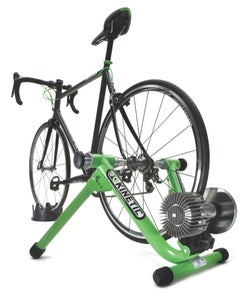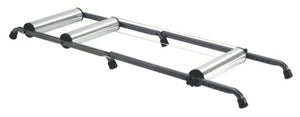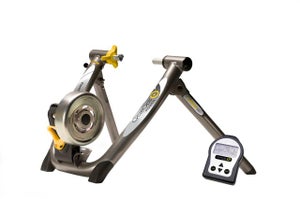New perk! Get after it with local recommendations just for you. Discover nearby events, routes out your door, and hidden gems when you sign up for the Local Running Drop.
It’s the time of year when many of us take our training indoors. Before you invest in a bike trainer, choose the type that will best serve your needs.
Written by: Courtney Baird and Aaron Hersh
Resistance-Only Trainers

A resistance-only trainer is a device that you can attach your bike to that allows you to ride in place while inside. The front wheel is kept still and the back wheel rolls on a roller. Depending on how much you want to spend, you can buy a wind, magnetic or fluid trainer, with the fluid trainers typically being the most expensive.
Pros: The resistance-only trainer allows you to stay upright on your bike without having to concentrate on staying upright, like you would outside. This allows you to zone out and watch TV, read a book or listen to music—activities you’ll likely want to do when you’re cooped up inside due to bad weather or pitch-black darkness. Fluid trainers, which usually cost around $300, simulate real riding better than any other type of resistance-only trainer and are generally the quietest.
Cons: Noise is the biggest negative. Wind trainers are usually the noisiest of resistance-only trainers but are also the cheapest. While fluid trainers are generally quieter, they are never noise-free. Additionally, wind and magnetic trainers offer riders limited resistance and never quite feel like real riding. In terms of durability, fluid trainers are prone to leaking while magnetic trainers are notorious for breaking down. So if you decide to purchase a trainer, be sure to get one with a solid guarantee policy.
Rollers

Rollers are made of three cylindrical drums, two of these drums support the rear wheel and one supports the front. The rider plants the bike on the drums and balances while pedaling without actually attaching the bike to the rollers. Pressing the tires into the drums creates resistance, and the rider controls his or her exertion level by shifting gears.
Pros: Rollers are the only style of indoor trainer that force riders to balance and control their bike in a way similar to riding on the road.
Cons: Riding on rollers forces the cyclist to focus on something other than riding hard, which makes it difficult to do an all-out workout.
Computer-based Trainers

A computer-based trainer is an electronically controlled version of a standard trainer, integrated with a power meter that measures the rider’s work level. The electronically controlled resistance unit can either precisely set resistance to make sure the rider trains at the exact prescribed work level, or it can allow the rider to cycle normally while it provides feedback about his or her work level without the delay or additional variables that can affect heart rate.
Pros: These trainers, such as the Cyclops PowerBeam and the Racer Mate CompuTrainer, allow the rider to train with more precision than any other style.
Cons: Cost is the only drawback to this type of indoor trainer. Models range from about $1,000 to more than $2,000.